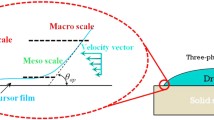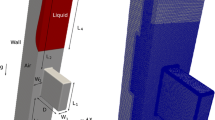Abstract
Recently, two regimes of viscous friction on textured surfaces were proposed in the context of penetration of liquid film into the texture (EPL 79, 56005 (2007)): the Poiseuille and Stokes regimes. With this idea on viscous friction, we theoretically discuss instabilities on a liquid film on textured surfaces when the film is forced to move with external forces. When a film recedes due to a pressure drop, we find scaling laws for instabilities to be checked in future experiments. When a circular film expands due to centrifugal force we find that the expanding film is stable against rim fluctuations (within the linear stability analysis) with its radius determined by a simple equation. Our discussion sheds light on the curvature of the front of the moving liquid film on textured surfaces and how the film thickness is kept fixed to the texture height on textured surfaces, aspects which have not been discussed in previous studies.
Similar content being viewed by others
References
P.G. De Gennes, F. Brochard-Wyart, D. Quéré, Gouttes, Bulles, Perles et Ondes (Belin, Paris, 2002).
J. Bico, C. Tordeux, D. Quéré, Europhys. Lett. 55, 214 (2001).
M. Callies, D. Quéré, Soft Matter 1, 55 (2005).
A. Otten, S. Herminghaus, Langmuir 20, 2405 (2004).
R. Narhe, D. Beysens, Phys. Rev. Lett. 93, 076103 (2004).
M. Tasinkevych, S. Dietrich, Phys. Rev. Lett. 97, 106102 (2006).
L. Courbin, E. Denieul, E. Dressaire, M. Roper, A. Ajdari, H.A. Stone, Nat. Mater. 6, 661 (2007).
N.A. Patanker, Langmuir 19, 1249 (2003).
A. Marmur, Langmuir 19, 8343 (2003).
C. Ishino, K. Okumura, D. Quéré, Europhys. Lett. 68, 419 (2004).
C. Ishino, K. Okumura, Europhys. Lett. 76, 464 (2006).
C. Ishino, K. Okumura, Eur. Phys. J. E 25, 415 (2008).
A. Dupuis, J.M. Yeomans, Langmuir 21, 2624 (2005).
H. Kusumaatmajya, J.M. Yeomans, Langmuir 23, 6019 (2007).
S. Moulinet, D. Bartolo, Eur. Phys. J. E 24, 251 (2007).
M. Reyssat, J.M. Yeomans, D. Quéré, EPL 81, 26006 (2008).
C. Ishino, M. Reyssat, E. Reyssat, K. Okumura, D. Quéré, EPL 79, 56005 (2007).
P.G. Saffman, G. Taylor, Proc. R. Soc. London, Ser. A 245, 312 (1958).
E. Guyon, J.-P. Hulin, Hydrodynamique Physique (Paris, CNRS Éditions, 2001).
H. Hasimoto, J. Fluid Mech. 5, 317 (1959).
F. Melo, J.F. Joanny, S. Fauve, Phys. Rev. Lett. 63, 1958 (1989).
L. Paterson, J. Fluid Mech. 113, 513 (1981).
L. Carrillo et al., Phys. Rev. E 54, 6260 (1996).
In the present case the determination of C rz is delicate from a geometrical point of view but we can determine C rz in this way, while in [25] and [23] the authors assumed essentially C rz = 0 in order to derive a solution to a non-fluctuating straight advancing front line and in [18] and [22] the authors assumed that 1/C rz is determined by the cell thickness from a geometrical viewpoint.
H.E. Huppert, Nature 300, 427 (1982).
In the usual case of spin coating where the film becomes thinner as it expands, the z-independent pressure p inside the liquid in eq. (21) can be set as the sum of the atmospheric pressure and the Laplace pressure jump due to the curvature of the film surface: p(r, ϑ) = p 0 +γ∇2 h(r, ϑ) in the region with weak curvatures [21]. However, in the present case, as in the cases of the spinning Hele-Shaw cell [22, 23], we cannot use this setting of pressure because the film thickness is assumed to be a constant (i.e., h is equal to the pillar height) on a sub-macroscopic scale: in the case of Hele-Shaw cell and in the present case the plate and pillars can tune pressure on the liquid as discussed in sect. 2, respectively.
If we could increase Δ, the spin coating could be performed up to a larger R without causing instability, which would be useful in industry. Unfortunately, the maximum of Δ is zero, as mentioned above.
Author information
Authors and Affiliations
Corresponding author
Rights and permissions
About this article
Cite this article
Hamamoto-Kurosaki, M., Okumura, K. On a moving liquid film and its instability on textured surfaces. Eur. Phys. J. E 30, 283 (2009). https://doi.org/10.1140/epje/i2009-10526-3
Received:
Revised:
Accepted:
Published:
DOI: https://doi.org/10.1140/epje/i2009-10526-3




